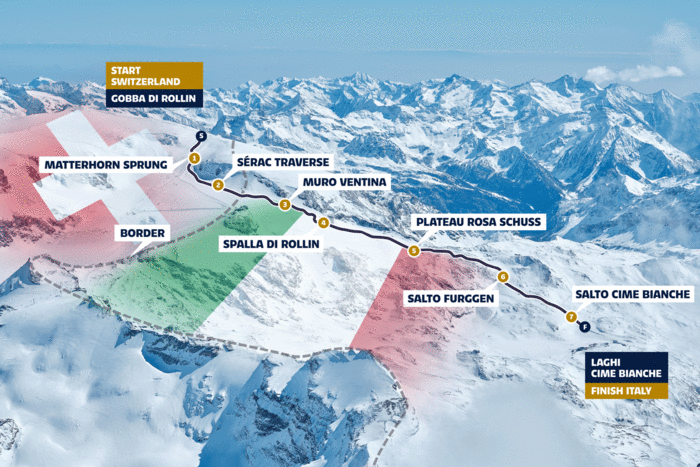
At the end of October 2022, top downhill athletes from all over the world will meet for the very first time for the season opener at just under 3,800 metres above sea level. The first cross-border World Cup race in history starts on Plan Maison above Cervinia. At the end of November 2019, the representatives of Cervino S.p.A. and Zermatt Bergbahnen AG met for their annual brainstorming session at the start of the season. One of the topics discussed was the new 3S cable car from Testa Grigia to the Klein Matterhorn, which connects Zermatt and Cervinia all year round in the highest ever Alpine crossing. During the discussions, the Italian representatives spontaneously suggested organising a World Cup downhill run from Gobba di Rollin across the border down to Laghi Cime Bianche when the Matterhorn Alpine Crossing cable car route was completed.
Driven by passion
Almost three years later, this vision has become a reality. Four downhill races will be held in total with men's races on 29 and 30 October and the women competing on 5 and 6 November. Christian Ziörjen, CEO of the Matterhorn Cervino Speed Opening, is convinced that it takes the right people to implement a project of this dimension in such a short time. And they have found them: “The passion, the dedication, the commitment of all the people who are working on this project is fantastic. Every person in the team shared one goal from the start: the races at the end of October.” As anticipated in a project like this, everything hasn't always run to plan: “The biggest challenge was and remains the cross-border cooperation. Zermatt and Cervinia are geographically close to each other and we all share a particular Alpine mindset. Nevertheless, the distance, cultural differences and language barriers sometimes present us with difficulties.”
Connected by the “big peak”
Nestled in a majestic panorama, the “Gran Becca” starts at 3,720 metres above sea level, making it the highest race course in the World Cup calendar. The downhill run at the foot of the Matterhorn comprises pure gliding passages, large and fast downhill curves and more technical sections with high speed and varied jumps. “The difference in altitude of 885 metres, the altitude itself, the length of 3.7 kilometres and the combination of natural and artificial snow will present the athletes with additional challenges,” says 2010 Olympic downhill champion Didier Défago. With two thirds of the course visible from the finish area in Laghi Cime Bianche, the course is also a non-plus ultra for spectators.
The athletes will compete from start to finish against the backdrop of the Matterhorn, probably the most photographed mountain in the world. The appeal and significance of the Matterhorn are undisputed in both Switzerland and Italy. In the Aosta Valley, the Matterhorn is often called “Gran Becca” – the big peak – in the local dialect. The course name underlines the positive cooperation and solidarity between the two regions.
Close to the athletes
Spectator capacity is limited to 6,000 places per race due to the course capacity and the location of the finish area. The first part of the race, from the start between the cable car stations of the two Plateau Rosa ski lifts to the Italian border, can be followed from the ski slope. There will also be a free public viewing zone on Testa Grigia on the Swiss side. Fans who want to experience the spectacle up close can head to the finish area on the Italian side. Tickets are available at https://www.zermatt.ch/en/World-Cup.
Off-piste entertainment
Alongside the programme in the finish area and on Testa Grigia, spectators can enjoy a supporting programme of activities in the two villages of Zermatt and Cervinia. On the men’s race weekend, the start number draw and the winners’ ceremony will take place in Zermatt; the events will switch to Cervinia for the women's race weekend. These events will be broadcast live to the other village and the races will also be screened publicly. This sporting festival will be supported with a programme of musical entertainment and local specialities.